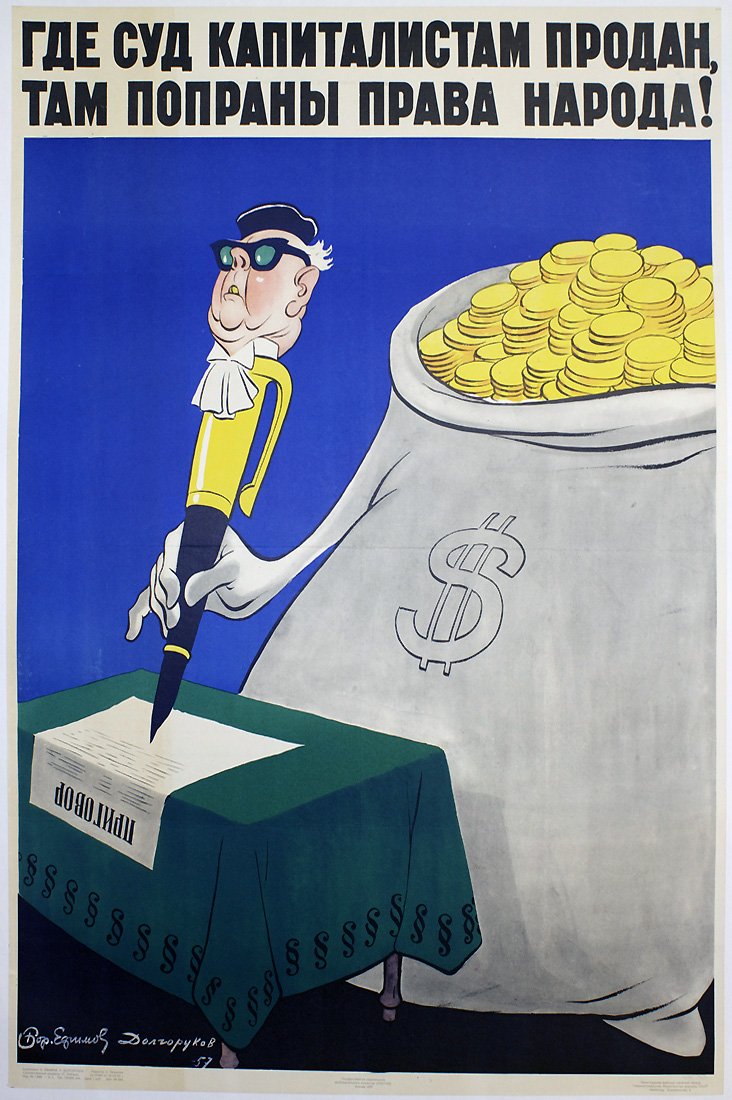
¡Dondequiera que un tribunal se vende a los capitalistas, allí se destruyen los derechos del pueblo!
Número de Cartel: PP 182
Información sobre el cartel: (En el papel sobre la mesa) “Sentencia”
Tamaño: 34x26
Tipo de cartel: Litografía y Offset
Fecha de publicación: 1957
Editores: Editor K. Nazarova; Artistic Editor Iu. Boitman
Información técnica: [Approved] August 19, 1957; Publication No. 1-588; Volume 1 sheet of paper; Order No. 694; Price 1 ruble
Ediciones: 125,000
Número de Glavlit: Sh-07384
En el catologo: PP 182 Cold War b
Artista: Efimov (Fridliand), Boris Efimovich — Ефимов (Фридлянд), Борис Ефимович
Boris Efimov (born Boris Efimovich Fridliand) revealed his creative industry at a young age, when in 1916, he produced a handmade school newspaper featuring his original drawings placed with the writings of his brother (and journalist to be) Mikhail Koltsov. Following a family move to Kharkov, Boris returned to Kiev in 1917 to study at the National Economic Institute and also to study under the law faculty at Kiev State University though he finished neither program. He ...
Leer más...
Artista: Dolgorukov, Nikolai Andreevich — Долгоруков, Николай Андреевич
In 1928, Nikolai Andreevich Dolgorukov moved from his native Ekaterinburg to Moscow to attend VKhUTEIN (Higher State Artistic and Technical Institute). After that organization dissolved in 1930, Dolgorukov continued his studies at the Moscow Polygraphic Institute under the tutelage of artists Lev Bruni and Dimitri Moor. Dolgorukov's training was in illustrated political satire as well as in poster design, and each area became the main focus of his long career. After graduation, he collaborated with fellow poster ...
Leer más...
Imprenta: Leningrad Offset Printing Plant — Ленинградское Офсетная типография
The Leningrad Offset Printing Plant was located near Kronverkskaia and Mir Streets in Leningrad (St. Petersburg). Historically, the printer had roots in Imperial Russia as a large operation founded in 1881 by Theodore Kibbel (Fedor Fyodorovich Kibbel') until it was nationalized by the Soviets in 1917. After its initial nationalization, the printer's management (via a series of government-controlled printing trusts) and its name both changed over the decades until it ultimately became the Leningrad Offset Printing Plant ...
Leer más...
Editorial: IzoGiz (State Publishing House of Fine Art), Moscow — Изогиз (Государственное издательство изобразительного искусства), Москва
The history of IzoGiz begins with the formation of Ogiz, the Association of the State Book and Magazine Publishers. In 1930, the Sovnarkom of the Russian Socialist Federative Soviet Republic established Ogiz to centralize publishing under a monopoly in order to eliminate duplication of printed material, to streamline and control publishing production and its output, and to create a base for marketing books, training and technical manuals. In 1931, the Central Committee of the USSR ordered certain ...
Leer más...